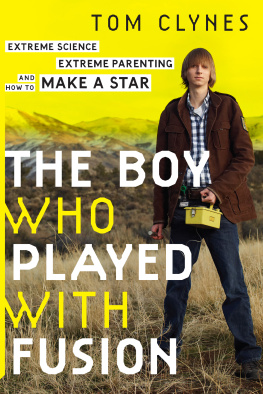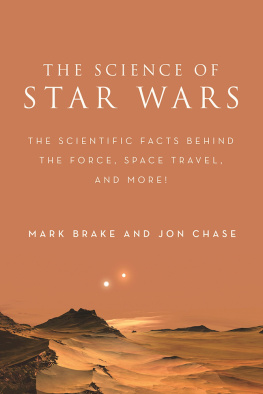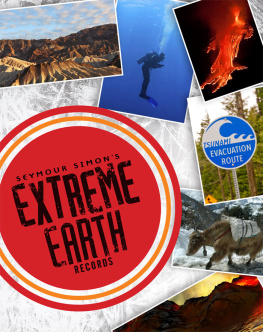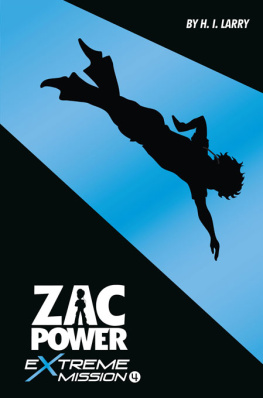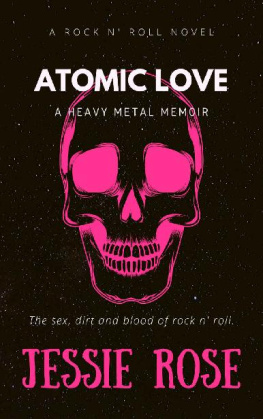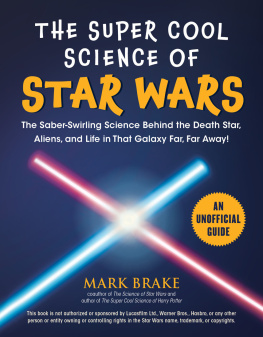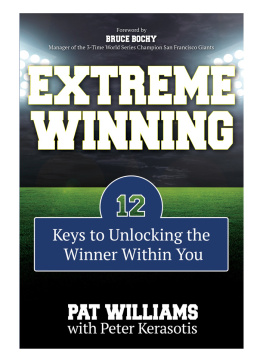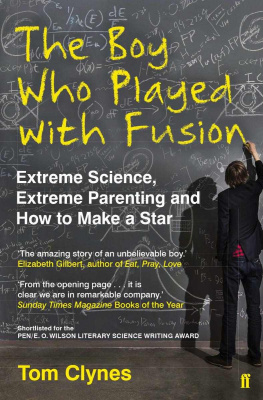Copyright 2015 by Tom Clynes
All rights reserved
For information about permission to reproduce selections from this book, write to Permissions, Houghton Mifflin Harcourt Publishing Company, 215 Park Avenue South, New York, New York 10003.
www.hmhco.com
The Library of Congress has cataloged the print edition as follows:
Clynes, Tom, author.
The boy who played with fusion : extreme science, extreme parenting, and how to make a star / Tom Clynes.
pages cm
An Eamon Dolan book.
Includes bibliographical references and index.
ISBN 978-0-544-08511-4 (hardcover) ISBN 978-0-544-08474-2 (ebook)
1. Wilson, Taylor, 1994 2. Gifted boysUnited StatesBiography. 3. Fusion reactors. 4. Nuclear fusion. I. Title.
QC774.W55C59 2015
539.7'64092dc23
[B]
2014048519
v2.0416
Cover design by Laserghost
Cover photograph Bryce Duffy Photography
Portions of this book originally appeared in slightly different form in Popular Science.
To my sons, Charlie and Joe
Penetrating so many secrets, we cease to believe in the unknowable. But there it sits nevertheless, calmly licking its chops.
H. L. MENCKEN
Add to this cruelly delicate organism the overpowering necessity to create, create, createso that without the creating of music or poetry or books or buildings or something of meaning, his very breath is cut off from him. He must create, must pour out creation. By some strange, unknown, inward urgency he is not really alive unless he is creating.
PEARL S. BUCK
Hi, my name is Taylor Wilson and I am 15 years old. I am an obsessive lover of all things nuclear and have a home amateur nuclear laboratory.
TAYLORS NUKE SITE HOMEPAGE
Introduction
P ROPULSION , THE NINE-YEAR-OLD says as he leads his dad through the gate of the U.S. Space and Rocket Center. I just want to see the propulsion stuff.
Situated next to the northern Alabama complex where NASA engineers designed and built the rockets that propelled Americas space program, the center showcases the worlds most impressive collection of high-flying hardware. Visitors can touch the scorched Apollo 16 command module, tumble-spin in a chair that mimics the frictionless vacuum of space, or command a mission in the space shuttles cockpit simulator.
But Taylor Wilson mostly wants to see the museums prize piece, the massive Saturn V rocket that launched mankind to the moon. Late that afternoon, father and son step inside the building built to house the reclining rocket, restored to its Apollo-era readiness. The tour guide, a young woman, leads their group of parents and children along the 363-foot-long behemoth suspended above the floor. As they duck under its five exhaust nozzles, each a dozen feet across, Kenneth Wilson glances at his awestruck boy and feels his burden beginning to lift. For a few minutes, at least, someone else will feed his sons relentless appetite for knowledge.
The docent tells the group that the Saturn V is the most powerful rocket ever built. Churning out a million and a half pounds of thrust, it boosted America decisively past the Soviets, spiriting two dozen Apollo astronauts to the moon. Though the three-stage rocket is retired now, the guide says, it remains unmatched in its capacity to lift men and gear beyond the tug of Earths gravity. Producing thirty-two million horsepower at full blast, the Saturn could accelerate a spaceship from zero to seventeen thousand miles per hour in eight minutes.
Then Taylor raises his handnot with a question, but an answer. He knows what makes this rocket go up. And he wantshe needsto tell everyone about it, about how acceleration relates to exhaust velocity and dynamic mass, about payload ratios, about the mix of kerosene and liquid oxygen that the first stage burned at six thousand pounds per second. The guide takes a step back, yielding the floor to this slender, overexcited kid whos unleashing a torrent of PhD-level concepts in a deep-Arkansas drawl as if there werent enough seconds in a day for him to blurt it all out. The other adults step back too, perhaps jolted off balance by the incongruities of age and audacity, intelligence and exuberance.
The nine-year-old tells the group that he designs and builds his own rockets at home in Texarkana. Next, hes talking about the Saturns solid-fuel second and third stages, the comparative advantages of their propellants, the tradeoffs rocket designers make between thrust and cost, weight and safety. As the guide runs to fetch her bossYou gotta see this kid!Kenneth feels the weight coming down on him again.
He and his wife, Tiffany, have done everything they can to nourish their older sons manic, metastasizing curiosity. Since the first moments of his existence, Taylor has complicated, confounded, and chaoticized nearly every detail of his familys lives. Indeed, Kenneth will look back on this particular day as one of the uncomplicated ones, when his scary-smart son was into relatively simple things, like rocket science.
This was before Taylor transformed the familys garage into a trove of glowing rocks and liquids and metals with enigmatic and terrifying powers... before he built a reactor that could hurl atoms together in a 500-million-degree plasma core, becoming, at fourteen, the youngest person on Earth to achieve nuclear fusion... before the creations of his restless intellect astounded everyone from the president of the United States to the audiences at TED Talks... before he conceived, in a series of unlikely epiphanies, new ways to use subatomic particles to confront some of the biggest challenges of our time: cancer, nuclear terrorism, sustainable energy.
This book had its beginnings in 2010 when, as a contributing editor at Popular Science magazine, I discovered a small community of nuclear physics enthusiasts, high-energy hobbyists who were taking on both the formidable theory and the precision engineering of applied nuclear science. The idea that self-taught amateurs outside the Big Science world of billion-dollar research laboratories were tinkering with nukesfusing atomic nuclei, transmuting elements, constructing atom-smashing machines in self-built laboratorieswas both intriguing and unsettling. Members of this guarded clique began to open up to me, and one of them mentioned a fourteen-year-old boy from Texarkana who had just become one of only thirty-two individuals on the planet to build a working nuclear fusion reactor, a miniature sun on Earth.
And yet, what would set Taylor apart was not his machine or his intellect but his buoyantly audacious approach to science, and life. Id met a few child geniuses, and I could tell immediately that Taylors genius was a different kind.
His is not the eyes-down, inwardly focused kind that skulks in the corner at the science fair. Nor is it the socially maladroit kind typified by Sheldon Cooper, the theoretical physicist in the television series The Big Bang Theory. Taylors genius is eyes-up and hands-on, and exuberantly connected to the universe. Indeed, it is his gift for creating connectionspersonal, intellectual, practicalthat has allowed him to build a world for himself that seems to have few limits.
Within two minutes of meeting him, says Stephen Younger, the former head of nuclear weapons research at Los Alamos National Laboratory, you realize that the kinds of things that most people think are impossible, Taylor just goes out and does.
You also realize that, despite his precocity and the Einsteinian zeal of his curiosity, Taylor is in many ways a normal kid with a normal (though often baffled) circle of family and friends, a normal teenagers series of crushes and confusions, and a still-developing identity. At first a timid child, he would burgeon into a garrulous, science-obsessed grade-schooler with a passion for explosive chemistry that would progress to an obsessive need to understand the mysteries of the subatomic world. At the age of eleven, distraught over his grandmothers impending death, Taylor would experience an illuminating moment in which hed envision not only a solution that could help millions but also an image of his future self, transformed from curious child to groundbreaking nuclear physicist. The clarity of his vision, and his belief that he could achieve it, would open new galaxies of possibilities for Taylor and sustain and motivate him as he pursued his unlikely dream.
Next page
